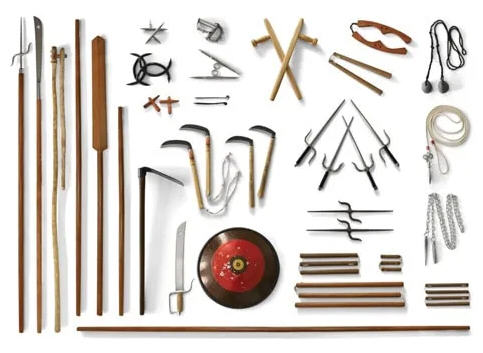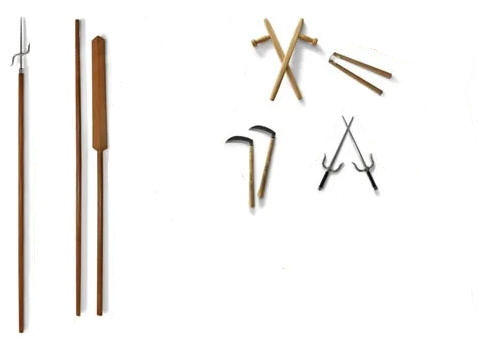Weapons Comparison
The traditional weapons of ancient Okinawa were usually derived from everyday farming and fishing tools. In Okinawan museums exhibits featuring ancient farming and fishing tools you can find examples of some of these “weapons”.
Matayoshi Kobudō
The Matayoshi family weapons style is less of a unified style and more of a grab bag of traditional Okinawan weapons plus weapons collected by Matayoshi Shimpō’s father, Matayoshi Shinkō, during his training in Okinawa and his travels in China.
There are so many weapons in the Matayoshi collection that one can hardly hope to master them all. Some of the weapons are of historic interest only, having no kata and are rarely practiced. In Sōke Kaichō Kinjō’s time, students were encouraged to choose a weapon to specialize in. Even though he trained in other weapons, Sōke Kaichō Kinjō chose the eku as his signature weapon.
The weapons kata of Matayoshi kobudō contain many movements that, while showy, cannot be made practical. Matayoshi Shimpō himself was not that interested in practicality. His driving goal was to pass on the weapons kata exactly as he learned them from his father, Matayoshi Shinkō. He would often refer students to Sōke Kaichō Kinjō for answers to questions about application.

d
Kōburyū
For the weapons of Kōburyū, Sōke Kaichō Kinjō chose a select group of the most traditional and commonly practiced Okinawan weapons.

The Weapons
Weapons of Both Matayoshi Kobudō and Kōburyū
- Roku shaku bō
The six foot staff (a shaku is a old Japanese measurement equal to 11.9303 inches) could be carried in public even during times when weapons were banned. - Sai
Not a hairpin or seed planting tool; sai were carried by the police as a symbol of authority. - Nunchaku
Nunchaku may have been derived from a primitive horse halter or soybean flail. - Tonkua
The origin of tonkua as a millstone handle is unlikely. Something like the tonkua was used to hang pots by the household fire. - Kama
Sickles remain in common use as farming and gardening and can be purchased in the hardware stores of Okinawa and Japan. - Eku
The narrow blade of the oar was used by ocean-going vessels. - Nunti
Not a fishing gaff; a weapon of ancient warfare adopted from China.
The nunchaku and tonkua were probably adopted from countries that the Ryūkyū Kingdom of ancient times traded with. Their exact origin and use is unclear, though there are many theories. Similarly, the nunti was adopted from the Ming Dynasty of China. It was used in Okinawa for stabbing, clubbing, blocking, and trapping enemies. It could be used to hook the lower leg of an enemy to throw him off balance.
Originally Sōke Kaichō Kinjō did not intend to include the kama in Kōburyū kobudō. However, in time he came to believe that kama, as a ubiquitous Okinawan tool, should be included.
Weapons Only of Kōburyū
- Tinaka
Tinaka are a small paired weapon held in the fists and used to enhance the effectiveness of blocks and punches. Tinaka were developed by Sōke Kaichō Kinjō, but they have a strong resemblance to tecchū. The tinaka kata clearly demonstrates the union of karate and kobudō into one style.
Weapons Only of Matayoshi Kobudō
- Yon shaku bō
Staff of about four feet in length - Kyū shaku bō
Staff of about nine feet in length - Jō
Sticks of short length used in pairs - Manji sai
Like sai but with the shaft pointed on both ends and the tines of the crosspiece curve in opposite directions. The manji sai can be mounted on a six foot staff to become a nunti - Kasurigama
Kama joined by rope or chain - Kuwa
Japanese-style hoe - Sansetsukon
Three sectioned nunchaku - Tekkō
Similar to brass knuckles but with pegs to trap a sword; said to have been devised from a stirrup (the loop with a flat base that supports the rider’s foot) - Tecchū
A small hand-held weapon like tinaka - Suruchin
A rope with weights (traditionally stones) on each end for throwing - Tinbe and rochin (short spear) or seiryuto (short sword)
A shield (originallly a tortoise shell) and short spear or sword - Kurumanbō
A threshing tool (third from the left)
